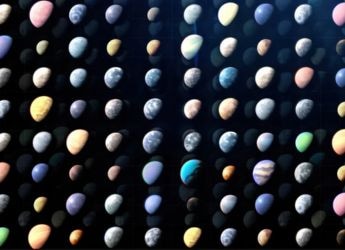- Home
- Science
- Science News
- NASA Tests Flexible Solar Array on Space Station
NASA Tests Flexible Solar Array on Space Station

Photo Credit: NASA
NASA is testing for the first time the effectiveness of a flexible solar array on space station that could one day power satellites and spacecraft.
The Roll-Out Solar Array, or ROSA, an advanced, flexible solar array that rolls out like a tape measure "can be easily adapted to different sizes, including very large arrays, to provide power for a variety of future spacecraft," NASA said.
It also has the potential to make solar arrays more compact and lighter weight for satellite radio and television, weather forecasting, GPS and other services used on the Earth.
In addition, the technology conceivably could be adapted to provide solar power in remote locations.
NASA tested the ROSA technology in vacuum chambers on the Earth several years ago, but this is its first test in space.
Over the weekend of June 17-18, 2017, engineers on the ground remotely operated the International Space Station's robotic Canadarm2 to extract the Roll Out Solar Array (ROSA) experiment from the SpaceX Dragon resupply ship.
The experiment will remain attached to the Canadarm2 over seven days to test the effectiveness of ROSA, NASA said.
Traditional solar panels used to power satellites can be bulky with heavy panels folded together using mechanical hinges.
The new solar array design rolls up to form a compact cylinder for launch with significantly less mass and volume, potentially offering substantial cost savings as well as an increase in power for satellites.
"When launching into space, mass and volume are everything, and ROSA is 20 percent lighter and four times smaller in volume than rigid panel arrays," explained principal investigator Jeremy Banik, senior research engineer at the Air Force Research Laboratory, Kirtland Air Force Base in New Mexico.
"You realise big cost savings from shaving off a little mass and volume, which makes it possible to raise bandwidth on a communications satellite and, for example, make GPS more accessible and reliable for everyone," Banik said.
Smaller and lighter than traditional solar panels, ROSA consists of a centre wing made of a flexible material containing photovoltaic cells to convert light into electricity.
On either side of the wing is a narrow arm that extends the length of the wing to provide support, called a high strain composite boom.
The booms are like split tubes made of a stiff composite material, flattened and rolled up lengthwise for launch.
The array rolls or snaps open without a motor, using stored energy from the structure of the booms that is released as each boom transitions from a coil shape to a straight support arm.
The technology of the booms has additional potential applications, such as for communications and radar antennas and other instruments, NASA said.
The ROSA investigation looks at how well this new type of solar panels deploys in the microgravity and extreme temperatures of space.
Get your daily dose of tech news, reviews, and insights, in under 80 characters on Gadgets 360 Turbo. Connect with fellow tech lovers on our Forum. Follow us on X, Facebook, WhatsApp, Threads and Google News for instant updates. Catch all the action on our YouTube channel.
Related Stories
- Samsung Galaxy Unpacked 2025
- ChatGPT
- Redmi Note 14 Pro+
- iPhone 16
- Apple Vision Pro
- Oneplus 12
- OnePlus Nord CE 3 Lite 5G
- iPhone 13
- Xiaomi 14 Pro
- Oppo Find N3
- Tecno Spark Go (2023)
- Realme V30
- Best Phones Under 25000
- Samsung Galaxy S24 Series
- Cryptocurrency
- iQoo 12
- Samsung Galaxy S24 Ultra
- Giottus
- Samsung Galaxy Z Flip 5
- Apple 'Scary Fast'
- Housefull 5
- GoPro Hero 12 Black Review
- Invincible Season 2
- JioGlass
- HD Ready TV
- Laptop Under 50000
- Smartwatch Under 10000
- Latest Mobile Phones
- Compare Phones
- Honor Win RT
- Honor Win
- Xiaomi 17 Ultra Leica Edition
- Xiaomi 17 Ultra
- Huawei Nova 15
- Huawei Nova 15 Pro
- Huawei Nova 15 Ultra
- OnePlus 15R
- Asus ProArt P16
- MacBook Pro 14-inch (M5, 2025)
- OPPO Pad Air 5
- Huawei MatePad 11.5 (2026)
- Xiaomi Watch 5
- Huawei Watch 10th Anniversary Edition
- Acerpure Nitro Z Series 100-inch QLED TV
- Samsung 43 Inch LED Ultra HD (4K) Smart TV (UA43UE81AFULXL)
- Asus ROG Ally
- Nintendo Switch Lite
- Haier 1.6 Ton 5 Star Inverter Split AC (HSU19G-MZAID5BN-INV)
- Haier 1.6 Ton 5 Star Inverter Split AC (HSU19G-MZAIM5BN-INV)

















